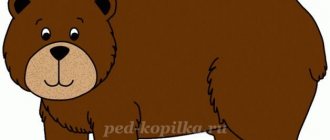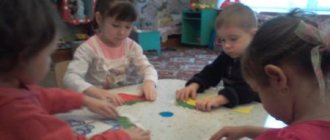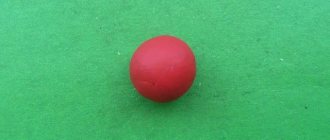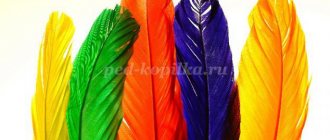Summary of a math lesson in the junior group "Square"
Game lesson in kindergarten using FEMP.
Junior group. Topic: Square Goals: to develop children’s ability to distinguish and correctly name a circle and a square, to practice examining figures in a tactile-motor way; improve children's combinatorial abilities. Material : large circle and square;
squares for examination by children - for each child; game "Geokont" - playing field and 2 rubber bands (large and small). A set of geometric shapes: circles and squares of different colors and sizes made of colored cardboard; unfinished “beads” (figures are glued onto a thin strip of paper in a certain sequence) in several versions of varying complexity. Course of the game-lesson
1. Introducing the square. The teacher tells a fairy tale:
“Once upon a time there was a circle.” He went for a walk, rolled and rolled along the path. (Puts the circle on the board.) Suddenly he sees someone strange, unlike him, coming towards him. (Puts out a square.) “Who are you?” - the circle was surprised. “I’m a square, and who are you?” “I am a circle. Let’s take a walk together, let’s ride along the path together.” I tried to roll the square, but it couldn’t. (Tries to roll the square.) The circle was surprised, began to look at the square and saw that the square has these 4 sides (circles them with his finger) and there are 4 corners - here they are (points). “Ah, I understand why you can’t roll,” the circle laughed. What do you guys think is stopping the square from rolling?
Children examine the square with their fingers and try to roll it.
They come to the conclusion that a square cannot roll, since it has corners, but a circle does not. 2. Game "Geokont". “Well, we didn’t manage to roll, let’s play,” suggested the circle. The children are given the game “Geokont” and two rubber bands.
The teacher suggests making a large square;
To do this, you need to secure the elastic band to the red nail, which is located at the very edge. Then for yellow. The teacher asks: “Did it turn out to be a square?” He suggests hooking the elastic band onto the blue nail: “Does it turn out to be a square?” Then you need to hook it on the purple nail: “Does it turn out to be a square? What is it: big or small? What color?” Then he suggests making a small square. He notes that you need to hook the rubber band onto studs of the same color, but suggests finding them on those closest to the middle. Children do the work by looking at the finished sample. - What did you do? —Which square: big or small? — What color did it turn out to be? - How many squares did we get? - They are identical? What is the difference? Physical education lesson Children perform movements in accordance with the text (excerpt from the song for the film “Cinderella”, lyrics by E. Schwartz, music by Spadavecchia).
Stand up, children, stand in a circle, …….
Children stand up in a round dance and walk in a circle.
Stand in a circle, stand in a circle.
Once upon a time there lived an old beetle,……. The teacher suggests making a large circle, a smaller one, a very small one.
Good old beetle...
3. Game “Collect beads”. - And now we will play with a circle and a square together and make beautiful beads with their help. Shows a string of beads with several alternating figures and says that the rest of the beads have scattered and the guys must help collect them using circles and squares. Each child is given a set of circles and squares and an unfinished string of beads. Focusing on the beginning of the beads, the child must continue working according to the algorithm until the end of the thread. Several alternation options are offered: by color, shape, size and by 2 characteristics. Assignments are given taking into account the individual characteristics of the child. 4. Summary of the lesson. - What wonderful beads they turned out to be! What shapes did we use? Who can we give beads to? Let's put them in an envelope and send our beads to the dolls as a gift.
We recommend watching:
Abstract of GCD for the formation of elementary mathematical concepts. Second junior group Notes of a lesson on FEMP in the first junior group of a preschool educational institution Notes of GCD in mathematics for the junior group of a kindergarten. Counting within 6 Lesson notes on the development of logical thinking in the younger group
Similar articles:
Math lesson notes. Theme: “One - many, big - small.” Second junior group
Math lesson notes. Topic: "Circle". Second junior group
Summary of a lesson on FEMP in kindergarten in the second junior group. Topic: “Spatial relations”
Summary of a lesson on FEMP in kindergarten in the second junior group. Triangles
Summary of lessons in kindergarten in the younger group. Topic: “Parts of the day”
Square. Big small. Left-right.
2 boxes of “Gnomes” to use
Summary of organized educational activities 2nd junior group “Dwarves”
Bookmark/Date:
16.10.2018.
Tarbieshi/ Educator:
Bokareva E. P.
I take salas/ educational area:
Cognition.
Pәn/ item:
FEMP.
Overall/ cross-cutting theme:
"My family".
Takyryby/topic:
Square. Big small. Left-right.
Maksattaras/goals:
formation of the concept of a square, the ability to recognize and name geometric shapes. Continue learning to compare two objects of contrasting length (short-long); continue to navigate on a sheet of paper (left-right); introduce the geometric figure – square; develop the ability to examine a square by tactile-motor means; trace the square by dots, understand that the square can be of different sizes (large or small), orient yourself on a sheet of paper; cultivate interest in drawing a new geometric figure.
Resurstarmen kamtamasyz etu / resource provision:
a square (large or small), one at a time, a workbook, red and blue pencils for each child.
Vocabulary work:
square.
Polygvaldyk component / polygval component:
tortburysh-square.
Ұyimdastarylgan oku қyzmetіnің Barysy – OUD:
1. Organizational moment :
A surprise moment.
(a bear in a box with a geometric figure - a square). Turns on a recording of the Bear roaring. He gets the children interested and asks: “Who is that roaring?” It seems he is roaring somewhere in our group, let's look for him. Show interest. They listen to the recording with a roar, they call it Bear.. - Oh, and Bear brought us something and takes out a geometric square figure from the box. Bear suggests remembering: -What geometric shapes do you already know? Together with the teacher, they find a box that moves, open it and take out a bear toy. Circle. -Do you want to get acquainted with a new geometric figure? Look, I brought you a square. Open your notebooks, find the same figure. They open their notebooks.
2. Negіzi bolіmі/main part:
Game “Circle the square”.
Working with a workbook (task 1, Fig. 1)
.
Invites us to consider a new geometric figure - a square.
They are considering. Vocabulary work:
square.
Repeat: square. Bilingual component:
square-tortburysh
.
Repeat: square-tortburysh.
Gives the task to move your finger along the arrows, as shown in the figure. Use a red pencil to circle a large square, and a blue pencil to circle a small square. Complete tasks. -Which square was circled with a red pencil? Big. -Which square was circled with a blue pencil? Small. -What is the name of the geometric figure that you circled? Square. Conducts individual work. Game “Guess First”
(Task 2, Fig. 2) Draws children’s attention to the drawing and says that these are two sisters, they are very similar, and only the most attentive children will be able to name and find the differences between the sisters. Look at the drawing. -What is the difference? One sister has short braids, and the other has long braids.
Physical education
Like clubfooted Misha, Let's all walk quietly, Then we'll walk on our heels. And then on your toes. Then we will walk faster and quickly start running.
Perform movements according to the text of the poem.
Game "Hint the path"
(task 3, Fig. 3)
.
He asks a riddle: He sleeps in a den in winter, under a huge pine tree, and when spring comes, He wakes up from sleep. They listen and guess the riddle. Bear. Mishka is happy that the riddle is about him. Mishka offers to find him in the picture, says that he loves honey. -Who is to the left of the bear? Bees. -What is to the right of the bear? A barrel of honey.
The bear asks the children: -Which direction should he go to find honey? Right. -And asks the children to draw a path from the bear to the barrel of honey. Draw a path from the bear to the barrel of honey.
3. Korytyndy / final part:
Mishka thanks the children for helping him get out of the box, helping him lead the path to the honey, and for this he gives them a geometric figure - a square. Show joy. Says goodbye and leaves. Say goodbye to the bear. -What new geometric figure did the bear give to the children? Square.
Summary of GCD for FEMP in the second junior group. Introducing the Voskobovich square
Abstract of GCD for children 3-4 years old “Introduction to V.V. Voskobovich’s square”
Objectives: Introduce V.V. Voskobovich’s two-color square. Develop sensory abilities and basic mathematical concepts. Form ideas about geometric shapes (triangle, square) at the image level. Activate children's speech and creative thinking. Develop fine motor skills of the fingers.
Progress of the lesson:
Children stand in a circle.
Low mobility game “All the children gathered in a circle.” I am your friend and you are my friend! Let's hold hands together and smile at each other. We'll hold hands and smile at each other. We'll go in circles. Let's start a round dance. (Walking in a circle) Guys, do you like fairy tales? (Children's answers.) Why do you love them? MAGIC AND VARIOUS MIRACLES HAPPEN IN FAIRY TALES. And in our kindergarten, miracles also happen. Look (fairytale music sounds) someone left us a chest, and what is there. The teacher takes out two-color squares. (Let the children touch and examine). Introduction to the Voskobovich square V.V. -Once upon a time there was a circle.
He went for a walk, rolled and rolled along the path. Suddenly he sees someone strange, unlike him, coming towards him. -"Who are you? - the circle was surprised. - “I’m a square, and who are you? " -“I am a circle. Let's ride down the path together." -I tried to roll the square, but it couldn’t. The circle was surprised, began to look at the square and saw that the square had corners. “Oh, I understand why you can’t roll,” the circle laughed. -What do you guys think prevents the square from rolling? History: In the most ordinary city, in the most ordinary house, there lived a very ordinary family: mother is a trapezoid, father is a rectangle and their son is Square. The square had no brothers or sisters, but there was a grandfather, a quadrangle, who lived in another city. Grandfather lived far away and therefore often wrote letters. One day dad said that yesterday he again received a letter from grandfather. Grandfather says hello to everyone, wishes them good health and asks who his favorite square dreams of becoming. Transformation of a square. (House). After breakfast, mom and dad left, and the square was left at home alone. I wonder what I can become? — Kvadrat remembered his grandfather’s question and went to the mirror. An ordinary square was looking at him, with all sides equal and all angles equal. (run your finger along the side of the square, find the corners) “The same everywhere and unremarkable,” the square thought to himself. On one side I am green, and on the other (children turn over the square) I am (what?) red. After that, our square decided to go out into the yard. He went out, walked along the path to the park, and suddenly in the depths of the park he saw a beautiful house. “I wish I could become such a house,” thought the square and suddenly felt that its corners began to move, and it somehow formed unusually. And the square turned into a house!!! (put the square in a square, bend the top corners)
He was very surprised and turned into a square again. These are some interesting squares we have. Did you like it? What did you guys like about them?
We recommend watching:
GCD in mathematics in the second junior group. Summary of GCD for FEMP in junior group 2. Summary of GCD for FEMP on the topic: Circle. Second junior group Notes of GCD in mathematics in the junior group of kindergarten. Geometric figures
Similar articles:
Mathematics day in kindergarten in the second junior group





